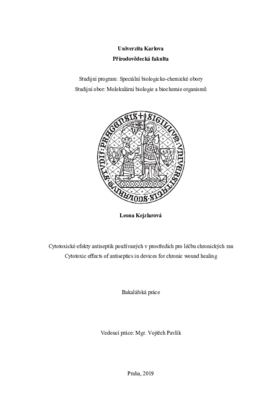Cytotoxické efekty antiseptik používaných v prostředcích pro léčbu chronických ran
Cytototoxic effects of antiseptics in devices for chronic wound healing
bakalářská práce (OBHÁJENO)

Zobrazit/
Trvalý odkaz
http://hdl.handle.net/20.500.11956/109610Identifikátory
SIS: 209674
Kolekce
- Kvalifikační práce [21483]
Autor
Vedoucí práce
Oponent práce
Hrdý, Jiří
Fakulta / součást
Přírodovědecká fakulta
Obor
Molekulární biologie a biochemie organismů
Katedra / ústav / klinika
Katedra buněčné biologie
Datum obhajoby
10. 9. 2019
Nakladatel
Univerzita Karlova, Přírodovědecká fakultaJazyk
Čeština
Známka
Výborně
Klíčová slova (česky)
Chronické rány, antiseptika, cytotoxicita, oktenidin, chlorhexidin, polyhexamethylen, PHMB, jod, stříbro, chlorKlíčová slova (anglicky)
Chronic wounds, antiseptic, cytotoxicity, octenidine, chlorhexidine, polyhexamethylen, PHMB, iodine, silver chlorChronické rány jsou často kolonizovány patogenními bakteriemi. Výskyt infekce na povrchu rány má za následek zhoršený a opožděný proces hojení. Proto je nutné mikrobiologickou zátěž odstranit použitím antimikrobiálních činidel, která navíc působí jako prevence proti infekci. Mezi antimikrobiální látky patří antibiotika, proti kterým si však patogeny umí vytvořit resistenci. Pro léčbu chronických rán se tedy používají antiseptické přípravky působící neselektivně. Antiseptika však mohou být cytotoxické i pro buňky lidské tkáně a způsobit tak zpoždění hojení ran. Je třeba dosáhnout určité rovnováhy mezi antimikrobiální účinností a cytotoxicitou. Nejčastěji používané aktivní látky s mikrobicidními schopnostmi v antiseptických přípravcích jsou: stříbro, jod, chlor, oktenidin, polyhexamethylen a chlorhexidin. Tato práce popisuje mechanismy působení těchto činidel a porovnává dosavadní klinické a laboratorní poznatky o jejich efektivitě na hojení chronických ran a cytotoxicitě proti buňkám podílejících se na tomto procesu. Klíčová slova: Chronické rány, antiseptika, cytotoxicita, oktenidin, chlorhexidin, polyhexamethylen, PHMB, jod, stříbro, chlor
Chronic wounds are often colonized by pathogens bacteria. The occurrence of infection on the surface results in an injured and delayed healing process. Therefore, the use of antimicrobial agents that eliminate microbiological stress and prevent infection is required for the treatment of chronic wounds. Microbial agents include antibiotics, but pathogens are able to develop resistance to them. Antiseptic agents are therefore used, which act non-selectively. Antiseptics may be cytotoxic to human tissue cells and cause a delay in wound healing. A certain balance needs to be struck between antimicrobial activity and cytotoxicity. The most commonly used active substances with microbicidal properties in antiseptic preparations are: silver, iodine, chlorine, octenidine, polyhexanide, and chlorhexidine. This work describes the mechanisms of action of these agents and compares the clinical and laboratory knowledge of their effectiveness in chronic wound healing and cytotoxicity against cells involved in this process. Keywords: Chronic wounds, antiseptic, cytotoxicity, octenidine, chlorhexidine, polyhexamethylen, PHMB, iodine, silver, chlor
